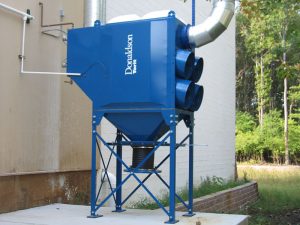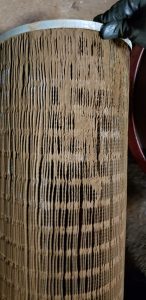PROBLEM: SysTech received a call about premature filter failure in a Donaldson Torit DFO 2-8 cartridge dust collector. The cartridge filter life went from over a year down to just three months.
APPLICATION: The client was cutting small metal pieces from painted carbon steel sheet stock. The dust collection system captured smoke from three (3) manually operated plasma cutting stations.
PROCESS: A Donaldson Torit model, DFO 2-8 cartridge dust collector, was installed in 2015 and had been operating effectively with Ultra-web cartridge filters for over a year. The dust collector was paired with a 10 HP exhauster, controlled by a Variable Frequency Drive (VFD) and filters were being continuously cleaned with compressed air. The design air-to-cloth-media ratio (AMR) was 2.3:1 with a total airflow of 3,000 CFM.

Our typical approach is to question the client, collect the facts and work through a series of viewed and suspected issues:
Step 1. Filter plugging
When the original set of Ultra-Web filters decreased in life, we sent the filters to Donaldson Company for Filter Analysis Testing. It was determined that the filters were building up a cake within the pleats, indicating there was some type of moisture or other product in the airstream. The client acknowledged the stock materials being cut had paint on the outer layer that was being burned off during the process. This type of smoke will contribute to dust caking, so we installed a set of filters with a wider pleat spacing, Fibra-Web. Although the filter life improved, the issue was not solved to our satisfaction.
 Step 2. Filter abrasion
Step 2. Filter abrasion
It was reported that the filters had small tears on the surface of the media. It’s not unusual to find that compressed air is turned up too high with the assumption of “more air pressure more thorough cleaning”. The recommended cleaning pressure for this collector is 90-100 PSI, and upon investigation, the pulse cleaning pressure was set at 120 PSI.
Step 3. Duct Velocity/Airflow
We checked the duct velocities in the drops and main trunk with a pitot traverse and found velocities higher than design. The VFD was adjusted to the highest setting, with duct velocity at 6000 fpm. This, in turn, increased the AMR, packing the pleats and preventing effective filter back flushing. Original design velocity was 4000 fpm. After tuning the fan speed down, the filter life issue did not show a significant improvement.
Step 4. Process Change
At this point, we started to think that the collector was undersized. But how did the system function correctly as designed for several years? So, we went back to square one and started into a second round of questioning and discovered that the process had changed. The plasma cutting process was changed and went from a manual cutting of 600 pieces to robotic plasma cutting of 1500 plus pieces. The collector was not sized to handle this kind of dust loading and hence the filter life issue.
Are you experience filter life issues with your dust collector? Don’t blame the collector until you review all the key variables. And dig a little deeper with your questioning.
If you have questions regarding dust collector application changes, please contact SysTech at 800-456-9460 to discuss what you may need to adjust your system.

 Step 2. Filter abrasion
Step 2. Filter abrasion
